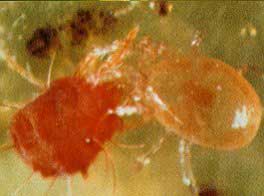Successful breeding spiders catch prey to protect plants
Experts in the Department of Insects, Department of Agricultural Sciences in Hanoi Agricultural University 1 have just completed the process of breeding prey spiders for domestic use except red spiders, aphids and pests of vegetables, beans, roses, green squash , oranges and tomatoes instead of chemical pesticides, contributing to improving production efficiency, quality of agricultural products and protecting ecological and human health environments.
 This is a spider species available in the natural environment in Vietnam, with the scientific name Amblyseius.sp. They grow and grow best in natural areas with a temperature of about 25 degrees C. In the North, they usually grow from February to November.
This is a spider species available in the natural environment in Vietnam, with the scientific name Amblyseius.sp. They grow and grow best in natural areas with a temperature of about 25 degrees C. In the North, they usually grow from February to November.
The breeding process for this spider is quite simple, just by feeding them on bean sprouts, there are many red spiders for prey. In particular, it is necessary to plant beans in a clean environment. When the bean leaves 6 leaves, drop the red spider spider into the rate of 10 adults / tree. When the number of red spiders is high (about 500 individuals / tree), it is necessary to release spiders to catch prey (2-3 plants per tree).
Only after 7-8 weeks the number of prey spiders increased 13 times compared to the initial stocking density; then bring the spider to catch prey and its food to the vegetable growing areas, which need to be protected. In order for spiders to catch prey to grow and develop quickly in an environment with little red spiders, the authors also use white spiders and many other foods such as pollen and honey to replace them, helping to catch prey spiders. life.
Prof. Dr. Nguyen Thi Kim Oanh, the leader of the research team, said: The prey-catching spider has a short life cycle and high reproductive power; therefore, using spiders to catch prey to kill worms, aphids and spiders that harm plants in greenhouses, net houses are very suitable and effective. In addition, the research team has successfully cultivated the prey to prevent the thrips from harming vegetables and very much want to be popularized and deployed on a large scale, especially in areas where vegetables are grown.
- Spiders use 'bird prey'
- Mechanism to catch spooky prey of spiders
- How to identify harmful spiders on plant leaves?
- Use 'natural enemies' to replace pesticides
- 'Immobilized assassin' under the sand
- Surprised with fish-eating spiders
- The killer tree is also afraid of poison
- Spiders eat together and stay together
- Spiders can release silk to neutralize prey
- Spiders hide hidden crickets in the blink of an eye
- Spiders can 'hear human voices'
- Sea spider sucks live prey
 Why do potatoes have eyes?
Why do potatoes have eyes? 'Tragedy' the world's largest carnivorous life: Death becomes ... public toilet
'Tragedy' the world's largest carnivorous life: Death becomes ... public toilet Tomatoes were once considered 'poisonous' for 200 years
Tomatoes were once considered 'poisonous' for 200 years Detecting microscopic parasites on human face
Detecting microscopic parasites on human face